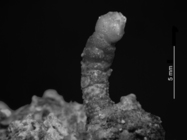Foraminifera taxon details
Sporadotrema Hickson, 1911
416008 (urn:lsid:marinespecies.org:taxname:416008)
accepted
Genus
Polytrema cylindricum Carter, 1880 accepted as Sporadotrema cylindricum (Carter, 1880) em. Hickson, 1911 † (type by original designation)
- Species Sporadotrema cylindricum (Carter, 1880) em. Hickson, 1911 †
- Species Sporadotrema differens McCulloch, 1977
- Species Sporadotrema errantium Hofker, 1926 †
- Species Sporadotrema mesentericum (Carter, 1880) em. Hickson, 1911 †
- Species Sporadotrema rubrum (d'Orbigny in Fornasini, 1908)
- Species Sporadotrema cylindrica (Carter, 1880) accepted as Sporadotrema cylindricum (Carter, 1880) em. Hickson, 1911 † (Genus is neuter)
- Species Sporadotrema mesentricum (Carter, 1880) accepted as Sporadotrema mesentericum (Carter, 1880) em. Hickson, 1911 † (Subsequent incorrect spelling)
marine, brackish, fresh, terrestrial
neuter
Hickson, S. J. (1911). On Polytrema and some allied genera. A study of some sedentary Foraminifera based mainly on a collection made by Prof. Stanley Gardiner in the Indian Ocean. [The Percy Sladen Trust Expedition to the Indian Ocean in 1905 under the leadership of Mr. <em>J. Stanley Gardiner. Volume III.] Transactions of the Linnean Society of London (2, Zoology.</em> 14(3): 443-462.
page(s): p. 447 [details]
page(s): p. 447 [details]
Diagnosis Test attached, up to 27 mm in height, early stage planispirally coiled, later chambers spiralling upward to form a large...
Grammatical gender ICZN 30.1.2. a genus-group name that is or ends in a Greek word transliterated into Latin without other changes takes the...
Diagnosis Test attached, up to 27 mm in height, early stage planispirally coiled, later chambers spiralling upward to form a large cylindrical upright and terminally branching structure, large chambers on the branches communicating by open passages, central core formed by irregular vertical tubes that spiral up the trunk and branches, to open distally on the branches; wall calcareous, hyaline, with irregularly scattered coarse perforations that result from outward fusion of the finer pores at the inner wall surface, inner septal walls imperforate, surface lacking both the areolae of Homotrema and the pillar-pores of Miniacina; early upright spiralling chambers with terminal aperture that remains as a foramen connecting successive chambers, an additional opening leads into the axial network of stolons that in turn open to the exterior at the ends of the branches. Eocene to Holocene; cosmopolitan in warmer waters. (Loeblich & Tappan, 1987, Foraminiferal Genera and Their Classification) [details]
Grammatical gender ICZN 30.1.2. a genus-group name that is or ends in a Greek word transliterated into Latin without other changes takes the...
Grammatical gender ICZN 30.1.2. a genus-group name that is or ends in a Greek word transliterated into Latin without other changes takes the gender given for that word in standard Greek dictionaries;
The suffix -trema comes from the Greek τρῆμᾰ (neuter): hole, aperture, perforation.
Hickson (1911, p. 452) indicates: "Of the genus Sporadotrema I recognise two species, S. cylindricum (Carter) which is fully dealt with in this paper and S. mesentericum (Carter)." Hickson clearly considers his genus to be neuter. [details]
The suffix -trema comes from the Greek τρῆμᾰ (neuter): hole, aperture, perforation.
Hickson (1911, p. 452) indicates: "Of the genus Sporadotrema I recognise two species, S. cylindricum (Carter) which is fully dealt with in this paper and S. mesentericum (Carter)." Hickson clearly considers his genus to be neuter. [details]
Hayward, B.W.; Le Coze, F.; Vachard, D.; Gross, O. (2021). World Foraminifera Database. Sporadotrema Hickson, 1911. Accessed at: https://www.marinespecies.org/foraminifera./aphia.php?p=taxdetails&id=416008 on 2025-05-13
Date
action
by
2009-09-23 14:01:30Z
created
db_admin
original description
Hickson, S. J. (1911). On Polytrema and some allied genera. A study of some sedentary Foraminifera based mainly on a collection made by Prof. Stanley Gardiner in the Indian Ocean. [The Percy Sladen Trust Expedition to the Indian Ocean in 1905 under the leadership of Mr. <em>J. Stanley Gardiner. Volume III.] Transactions of the Linnean Society of London (2, Zoology.</em> 14(3): 443-462.
page(s): p. 447 [details]
additional source Loeblich, A. R.; Tappan, H. (1987). Foraminiferal Genera and their Classification. Van Nostrand Reinhold Company, New York. 970pp., available online at https://books.google.pt/books?id=n_BqCQAAQBAJ [details] Available for editors [request]
[request]
page(s): p. 447 [details]
additional source Loeblich, A. R.; Tappan, H. (1987). Foraminiferal Genera and their Classification. Van Nostrand Reinhold Company, New York. 970pp., available online at https://books.google.pt/books?id=n_BqCQAAQBAJ [details] Available for editors
From editor or global species database
Diagnosis Test attached, up to 27 mm in height, early stage planispirally coiled, later chambers spiralling upward to form a large cylindrical upright and terminally branching structure, large chambers on the branches communicating by open passages, central core formed by irregular vertical tubes that spiral up the trunk and branches, to open distally on the branches; wall calcareous, hyaline, with irregularly scattered coarse perforations that result from outward fusion of the finer pores at the inner wall surface, inner septal walls imperforate, surface lacking both the areolae of Homotrema and the pillar-pores of Miniacina; early upright spiralling chambers with terminal aperture that remains as a foramen connecting successive chambers, an additional opening leads into the axial network of stolons that in turn open to the exterior at the ends of the branches. Eocene to Holocene; cosmopolitan in warmer waters. (Loeblich & Tappan, 1987, Foraminiferal Genera and Their Classification) [details]Grammatical gender ICZN 30.1.2. a genus-group name that is or ends in a Greek word transliterated into Latin without other changes takes the gender given for that word in standard Greek dictionaries;
The suffix -trema comes from the Greek τρῆμᾰ (neuter): hole, aperture, perforation.
Hickson (1911, p. 452) indicates: "Of the genus Sporadotrema I recognise two species, S. cylindricum (Carter) which is fully dealt with in this paper and S. mesentericum (Carter)." Hickson clearly considers his genus to be neuter. [details]


